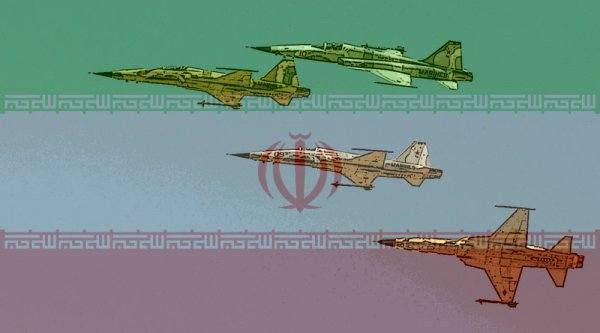

Iran has touted its allegedly homegrown ‘Kowsar’ jet fighter, finally unveiled to the public on Tuesday, as a new contender in the arena of air-to-air combat. But the new aircraft was immediately met with waveofcriticism from defense industry observers who saw the aircraft as a mere copy of the venerable F-5 which, although a sturdy airframe still in use by the United States military, is considered an antiquated product of the the age of slide rules and hand drawings. After all, boasting about a broadsword in the age of the machine gun is simply an invitation for ridicule.
However, behind the veil of Iran’s geopolitical misdirection and copyright ignorance sits a prime example of the industry that Tehran has managed to foster despite decades of sanctions — and a vision of a homegrown aviation industry to come.
#Iran 'Kowsar' indigenous fighter – prototype 3-7400 (2018)#US Northrop F-5F Tiger II combat capable trainer – prototype 00889 (1974) pic.twitter.com/b8vJ7qGd9n
— Joseph Dempsey (@JosephHDempsey) August 21, 2018
This is not the first time Iran has shown off a new weapon for propaganda purposes. The roundly-mocked Qahar stealth fighter model presented as the real deal in 2013 was an embarrassing unforced error by the Iranian military-industrial complex, one originally presented to show the Iranian people that their government could defend them against the best in the world, even if it really can’t.
But Iran has soldiered on with its own homegrown weapons, first used toeffect in Syria, then as an effective nuclear weaponsprogram, and now, indigenously produced aircraft. Since the fall of the Shah, Iran has coasted by on the wave of massive U.S. arms purchases made prior to the revolution: F-14 fighters were just one frontline jet sold to the country, while F-4 Phantoms and F-5 Tigers gave Iran a formidable air force, as the Iraqis unfortunately discovered during the decade-long war between the two.
In the intervening decades, those aircraft have fallen into disrepair. Highly-engineered parts from the U.S. could only be acquired by subterfuge, leading to the natural conclusion that Iran had to either invest in the human capital and industrial acumen to develop an aerospace industry, or make friends with someone who had one. Iran, of course is not a fan of the East or West, and Iran has little interest in buying Russian weapons despite recent overtures, leaving it with the hard choice to make its own.
The F-5 shown off this week is not the first so-called domestic fighter unveiled. In 2015, the twin rudder Saeqeh-2 made a small splash with a similar unveiling. Analysts quickly deduced it was crafted from the non-flying F-5s that Iran had sitting on tarmacs gathering dust. But it was also one more step towards the F-5 that was allegedly 100% produced from Iranian factories. In fact, Iranian Minister of Defense Amir Hatami was involved heavily in the showcase reveals of both fighters, apparently dead-set on showing the Iranian people that they, too, can produce a means to defend their country.
The F-5 itself may be an aging design, but for the purposes of regional air defense and training (or in Syria offense) it may be good enough. If Iran has managed to integrate newer avionics and radar systems, the F-5 knock-off could be a threat to be wary of. And Iran begins to produce the fighter in numbers, their aerospace manufacturing base will only improve.
This isn’t to say we will see a actual Iranian stealth fighter anytime soon, but if Iran can make their own engines, their own fuselages, and their own computer systems, it’s only a matter of time until they field something that we will have to be worried about. Much like China’s ability to produce aircraft carriers or India’s ability to detonate nuclear weapons, the United States has seen time and again what happens when an opponent is underestimated.

A enlisted thinktank brought to you by Task & Purpose
